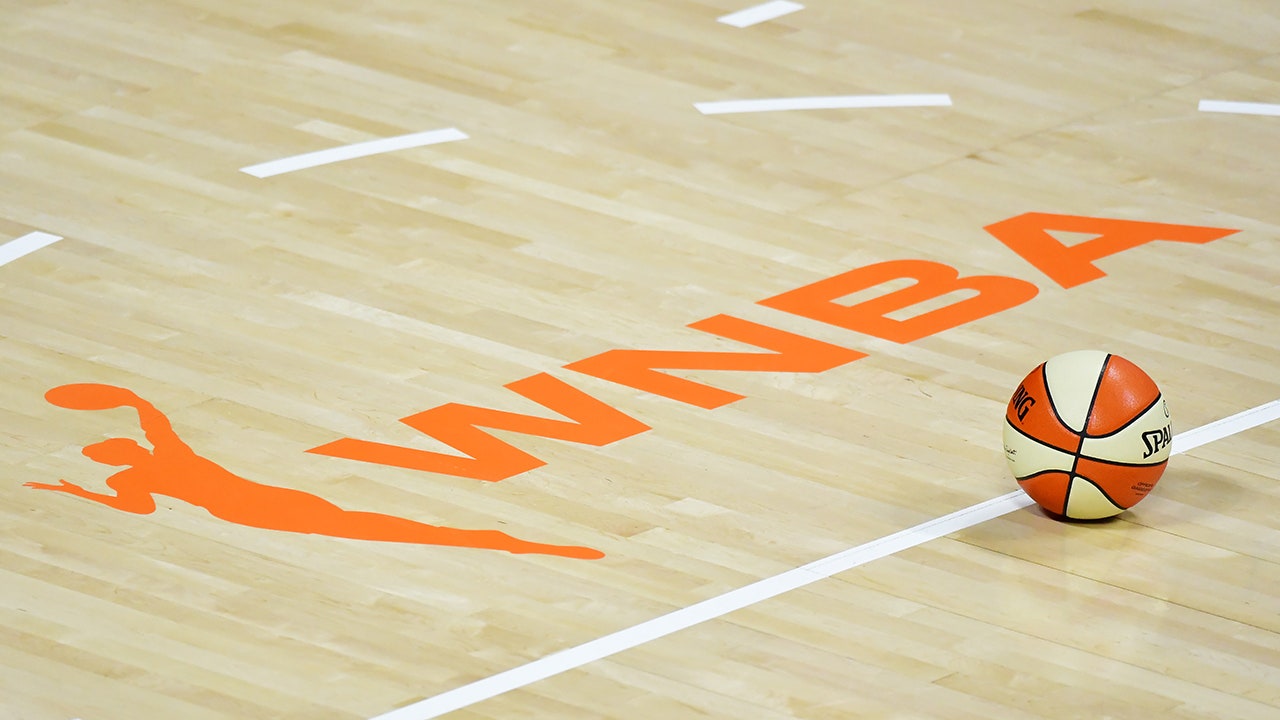WINNIPEG – Three hours before puck drop, Greg Burnett awaited the fate of his beloved Winnipeg Jets, on the brink of elimination.
The 56-year-old retired high school teacher stood in a fenced-off courtyard, just beyond a statue of the late Jets legend Dale Hawerchuk, between the glittering reflection of newly developed office towers on what used to be a vast parking lot in Winnipeg’s age-worn downtown.
Burnett felt optimistic. He calls it a glass-half-full mentality when his team is “paradoxically aligned with impending doom.”
He sipped a Michelob Light as hundreds of Jets fans filled the streets around Canada Life Centre ahead of Game 5 of the team’s first-round playoff series against the Colorado Avalanche, trailing 3-1.
The stakes that night felt particularly high. The Jets’ successful regular season (second in the NHL’s Western Conference) was clouded by dwindling attendance and concerning comments made by ownership about the team’s future.
Winnipeg is Canada’s seventh-largest city. With a population of 758,000, it is the NHL’s smallest market.
The prairie hub proudly leans into its reputation as a large “small town.” The region boasts a rich history in the game — and a passionate fan base.
But Winnipeg is often overlooked by players. The Jets appear with great frequency on the “no-trade” lists of many contracts. High-profile players like Jacob Trouba, Evander Kane and PL Dubois have all forced their way out of town. In The Athletic’s anonymous player poll, Winnipeg was declared the destination that players least liked to visit on the road, with 41.24 percent of the vote.
That sentiment has a galvanizing effect on the fan base.
“The perception is that people want us to fail,” Burnett said, adding that the Jets faithful embrace the team’s underdog position.
Burnett wore a white Connor Hellebuyck jersey, the team’s All-Star goalie who recently signed a seven-year deal to stay in Winnipeg and was named a finalist for the Vezina Trophy. Burnett’s jersey could have been any member of the current Jets roster, aside from the team’s most recent trade deadline acquisitions. He has a jersey for almost every player who has played multiple seasons in Winnipeg since the team’s return more than a dozen years ago. His collection includes more than 60 jerseys from two generations of the Jets.
I first met Burnett in 2011, when he was one of the 13,500 fans who signed up for season tickets in 17 minutes when the Atlanta Thrashers moved to the Canadian Prairies, becoming the second iteration of the Jets.
He gave me a tour of the basement he’d dedicated to the team that left the city for Arizona in 1996, which had become central to Burnett’s life. Celia Burnett relinquished the basement to her husband, knowing he needed a place to address his anger and sadness at the Jets’ move to Arizona. He turned it into a shrine that includes a miniature locker room, old jerseys, game programs and memorabilia that spoke to the love and agony that comes with being a fan. The final A from the Winnipeg Arena sign above the entrance of the now demolished building sat on a landing above the basement stairs. Gillian, the youngest of the Burnetts’ four daughters, helped her father show off his prized Jets possessions.
Gillian was 9 then. She’s grown up sitting in the family’s seats — section 312, row 5 — next to her father. She is now 22 and has a Winnipeg Jets tattoo on her forearm.
“I got it in honor of my dad, because that’s what my dad is — the Winnipeg Jets,” Gillian said. “It’s part of him.”
She sat next to her 78-year-old grandmother, Donna, on a concrete stoop in True North Square, as a DJ pumped music into the pregame festival. Donna, who wore a white and pink Jets zip-up hoodie, also never misses a game, not because of an obsession with an on-ice product but because of what the team means to her family.
In the late 1970s, Donna bought season tickets to the original Jets franchise. For a single mother, the Jets became a way for her to connect with her rambunctious 8-year-old son. They drove more than a half-hour to each game and always went out to a restaurant they considered to be fancy. At the time, it was all doable on Donna’s teacher salary.
“We had a wonderful time,” she said. “I just loved it.”

Greg Burnett at the entrance of his Jets shrine. (Dan Robson / The Athletic)
But that “wonderful time” didn’t last. In 1996, the original Jets franchise left for Arizona. When the ownership group True North announced in 2011 that it was purchasing the Atlanta Thrashers and moving the team to Winnipeg, Jets love was rekindled.
The NHL’s return kicked off a revival so fervent that the franchise nurtured a waiting list of several thousand people willing to purchase season tickets should a seat ever open up.
The Canada Life Centre is the smallest arena in the NHL, with a capacity of just more than 15,000. And for years the Jets boasted constant sellouts and one of the loudest fan bases in the league.
But over the past couple of seasons, the Jets have had only a handful of sellouts.
And then early this season, Greg Burnett started to feel that familiar pang of dread when he saw rows of empty seats inside the Jets home rink. It was a reminder of an underlying anxiety shared by many fans old enough to remember the first time the team left town.
It was just the second home game of the 2023-24 season and only 11,226 fans showed up to watch the team play the L.A. Kings, the lowest attendance Burnett said he had ever seen at a Jets game.
Things didn’t get much better. Aside from the smoldering ashes of the Arizona Coyotes — the former Jets franchise playing out its final days at a 5,000-seat college rink — Winnipeg had the lowest attendance in the NHL this season, averaging 13,490 fans. By percentage of rink capacity, the Jets were third worst at 89.9 percent, ahead of only the Buffalo Sabres and San Jose Sharks. In Winnipeg, it was the continuation of a downward trend that started with the NHL’s first full 82-game season after the Covid-19 pandemic.
The Jets’ season-ticket base shrunk by 27 percent in three years, falling to under 9,500 from close to 13,000.
The team’s mediocre results didn’t help. The Jets missed the playoffs in 2022, then lost in the first round after barely squeaking into the postseason in 2023.
Last spring, True North angered fans with a poorly conceived “Forever Winnipeg” ticket drive.
“So is Winnipeg an NHL city? You better believe it,” narrator Kenny Omega, a Winnipeg-born wrestling star asks over sentimental visuals of Jets highlights and smiling fans, before the background music turns abruptly somber. “But it takes all of us.”
The campaign was widely viewed as a not-so-veiled threat, recalling painful memories of the Jets’ departure.
In February, concern about the franchise’s future was stoked by comments Mark Chipman, True North’s chairman, made in an interview with The Athletic’s Chris Johnston.
“I wouldn’t be honest with you if I didn’t say, ‘We’ve got to get back to 13,000,’” Chipman told Johnston. “This place we find ourselves in right now, it’s not going to work over the long haul.”
In the upper bowl, behind the visiting goal — section 312, row 5 — Greg, Gillian and Donna took their regular seats in the sea of white. The rink filled quickly, as it had through the final stretch of the regular season when the Jets sold out six of the team’s last eight games. A late-season surge helped build excitement for the playoffs. The Jets carried an eight-game winning streak into the playoffs. They drew the Colorado Avalanche in the first round, a team they hadn’t lost to all season and had recently stomped 7-0.
Maybe the fans just needed a reason to believe?
If that hope was fleeting with the Jets trailing 3-1 in the series, you wouldn’t have noticed as the Jets took the ice for warmups in Game 5. The arena buzz rose to a crescendo.
Just after warmups, Celia Burnett met her family at their seats, taking a quick break from her job working at the front gate of Canada Life Centre, ushering lively fans through the ticket line at Portage Avenue. The family was at the arena so much that a few years ago she decided it made sense that she get paid to be close by.
“It’s a constant,” Celia said. “It’s always about the Jets.”
The arena thundered. The sold-out crowd twirled white towels and cheered at a relentless volume. Fans belted the words “True North” in unison when the Canadian national anthem lyrics were sung — a tradition that started with the team’s inaugural season in 2011.
Outside the Jets “whiteout” street party on Donald Street, next to the arena, another 5,000 fans packed as close to two massive projection screens. All wore white. Some reveled in more creative attire. Several wore full white bodysuits and white old-school goalie masks. One man wore a white beer-stained pinstripe suit. Another wore a Panda head.

Jets fans packed the streets around the Canada Life Centre for Game 5. (David Lipnowski / Getty Images)
Evan Chubaty wore a low-cut wedding dress he found at a thrift store, fastened by dirty shoelaces he borrowed from a pair of sneakers. He was 9 when the Jets arrived. He’s not worried about them leaving. He thinks the fans would never actually let that happen.
“Everyone loves them,” Chubaty said. “It’s a huge part of Winnipeg. The city wouldn’t be the same without them.”
Benny, the original Jets mascot, interrupted the conversation and got down on a furry blue knee in front of Chubaty.
The Bloodworth family stood quietly amid the crowd of mostly twentysomethings, reflecting both the older and younger generation of fans. Shayne and Maureen Bloodworth brought their children out for the experience. Shayne was a “1.0” Jets fan.
“I’m the old guy,” he said, as a crush of well-imbibed fans weaved around the family.
His 10-year-old twins — Max, who sat sleepily on his shoulders, and Jack who leaned against him — have grown up in the “2.0” era. They play minor hockey for the River East Royals and catch every Jets game they can stay awake for.
“It’s become a part of this city’s culture, for sure,” Shayne said. “It’s brought a lot of people together.”
Moments later, the street erupted as Josh Morrissey scored for the Jets halfway through the second period, tying the game at two. But before the period was over, Colorado was ahead again.
Greg Burnett admitted that his optimism was fading. The Jets were 20 minutes away from another first-round exit. Considering the empty seats of the regular season, the stakes felt especially high.
“I hope I’m wrong,” he said.
So is Winnipeg an NHL city?
Glen Hodgson, an Ottawa-based economist and expert in the economics of sports franchises, believes it is — but in a unique, inherently precarious way. Hodgson wrote a book on the business of sports franchises, developing a methodology with his co-author for evaluating whether a sports franchise would succeed or fail.
As a market, Winnipeg falls short in almost every key component. The population is too small, the per capita income is too low, and there are a dwindling number of corporations with a head office in Canada’s windy city.
“But then you get to the intangibles, like passion,” Hodgson said. “And Manitoba is off the chart.”
Hodgson knows the psyche of the city’s sports fans well. He grew up in Winnipeg and was a devoted follower of the CFL’s Winnipeg Blue Bombers, the other franchise that holds a deeply rooted place in the region’s culture and identity.
For many, like Burnett, the NHL’s return in 2011 was a miracle, faithfully prayed for.
Nostalgia and pride alone were enough to sell the team to local fans. For more than a decade, True North was viewed as a savior.
The franchise was able to operate in an “if you build it, they will come” mode, Hodgson said.
But after the pandemic, amid a wavering Canadian economy, high inflation, and growing dissatisfaction with rising prices, stringent policies and a perceived lack of appreciation from the organization, many fans decided to stay home. The magic faded. The season-ticket waiting list disappeared. And the franchise entered a new, critical era.
Chipman later clarified his comments about the franchise’s sustainability and season-ticket sales, saying he was referring to the team’s ability to spend to the cap and ice a contender. Gary Bettman, the NHL commissioner, visited Winnipeg this winter and underscored his confidence in the city as an ideal hockey market — which is something he has previously said about several other cities that ended up losing NHL teams.
But there is plenty of reason for Jets fans to be confident in the team’s commitment to Winnipeg.
The franchise’s books are kept private, but Chipman has said it’s never lost money since its inaugural NHL season. And there is plenty of cash underpinning it. David Thomson, one of True North’s co-owners, is the richest person in Canada — and 21st richest in the world — with a net worth of $61.3 billion, according to Forbes.
True North has also invested hundreds of millions into the city, revitalizing the area around Canada Life Centre with sparkling new office towers. Last year, the group announced a $500 million plan to redevelop a worn-down shopping center across the street from the arena, a healthcare and social services hub for the community.
Still, Winnipeg remains a constrained market, Hodgson said. There are only so many businesses and people to commit to season tickets.
Chipman has been candid about True North’s missteps in taking the community of Jets fans for granted. At the same time, fans like Burnett say it’s also on the community to re-up its commitment to the team. He’s reached out to friends who’ve let their season tickets lapse in recent years, urging them to come back.
The team’s future likely depends on that rekindled relationship.
“If you’re asking the fundamental question, is the market really big enough to sustain over time, it really depends on engaging the passion,” Hodgson said.
“If any city is going to make it with those limitations, it will be Winnipeg.”

The Jets didn’t have any trouble filling the stands for Game 5 of their first-round series against the Avalanche. (David Lipnowski / Getty Images)
As the Colorado Avalanche pulled away from the Jets, those passionate fans started to head for the exits. Before the final horn sounded on a 6-3 Avalanche win, large sections of the stands sat empty. Celia watched people stream through the doors onto Portage Avenue.
Gillian joined her friends who’d watched from the street party, which emptied off Donald Street within minutes. Hundreds of crushed silver cans sparkled beneath the street lights.
In section 312, Greg sat next to his mother, watching the teams shake hands, trying to process another lost opportunity. As the players left the ice, Greg helped Donna from her seat and carefully guided her down the steep stadium stairs.
He paused for a moment in the atrium, trying to describe the dejection he knew would linger until the Jets begin again. A deep playoff run would certainly have stoked deeper interest in the team across the city. But this first-round exit felt perilously familiar.
“You know, as a Winnipeger,” Greg said, “it feels like we can’t have nice things.”
Donna smiled softly. Her son extended his arm and she took it. They walked away together, disappearing among the fans left and leaving.
(Illustration: Eamonn Dalton / The Athletic. Photos: David Lipnowski / Getty Images; Jonathan Kozub / NHLI via Getty Images)






